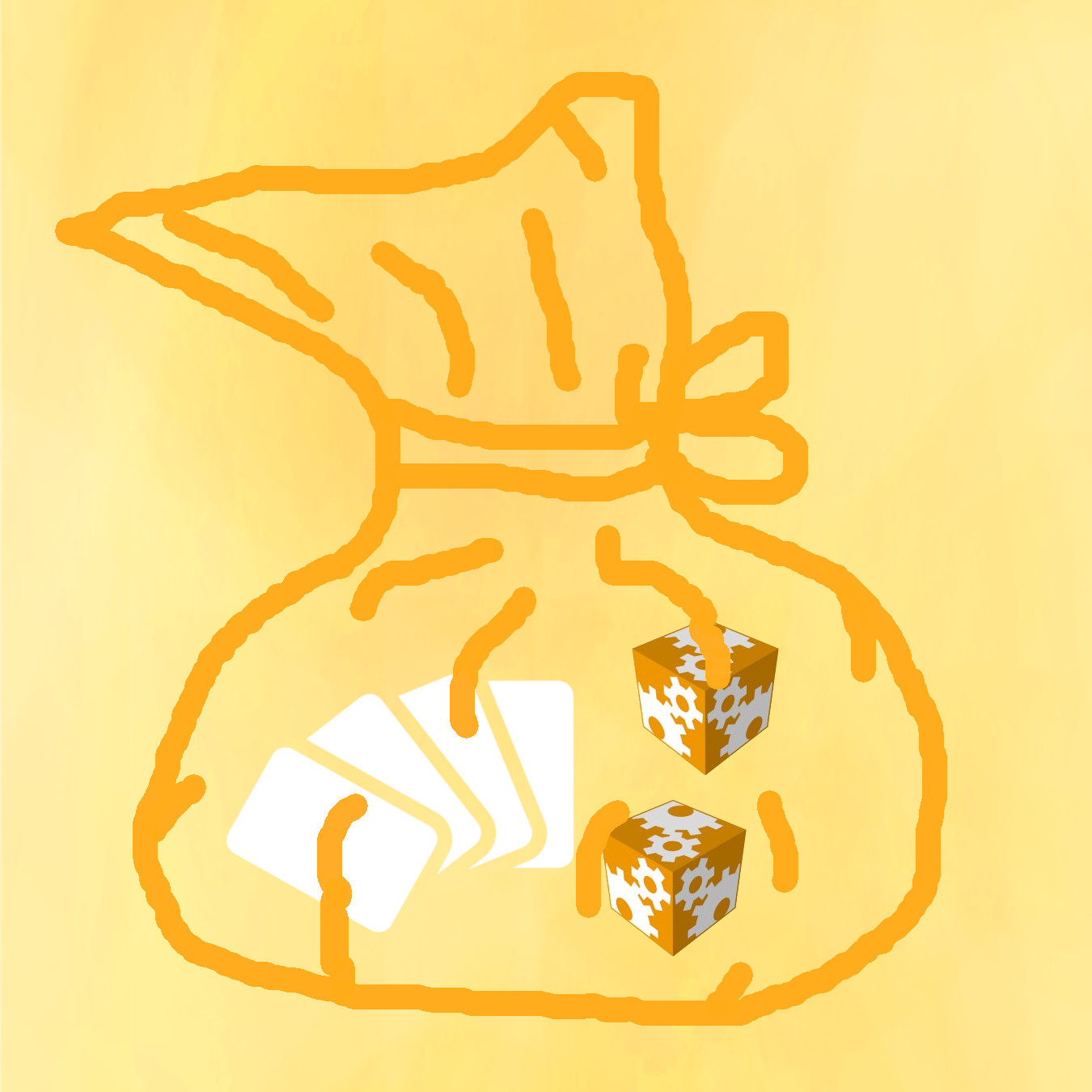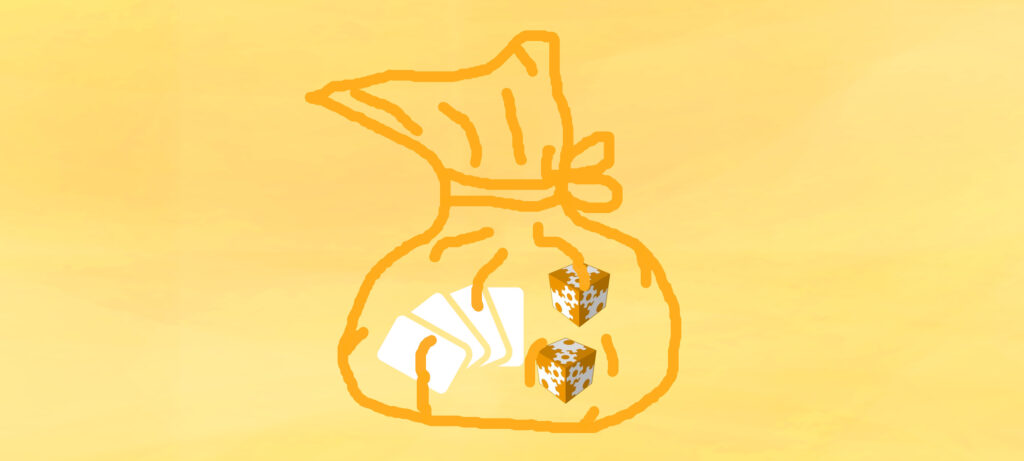
Randomness is an interesting concept. The right amount of randomness can make our lives more exciting and eventful, while too much randomness can become stressful or damage our sense of control.
Some level of randomness has become a part of most tabletop games, which leads us to the question, how much randomness should any given game include, and how can it best be implemented in the games we design and create?
See below for a few of my thoughts, and please share your own thoughts and perspective on randomness in games using the comment form below.

Overview of Random Selection
Random selection in tabletop games entails (1) having one or more aspects of your game vary based on chance and (2) having an efficient and engaging randomizer. Each of these is important, but can be highly customized based on your particular game.
Aspects that might vary based on chance might include board layout, player set-up, action or resource selection, selection from custom collections, and more. Randomizers might include dice, card decks, component bags, tile stacks, and more.
Random selection is nearly ubiquitous in tabletop games, and though strictly strategy games do not need it, controlled and well-designed random selection can help increase a game’s audience, replay value, and variability.
Important Considerations with Random Selection
Let’s quickly go over a few important considerations with many aspects that could use random selection and several randomizing tools that we might use.
Below are some of the possible aspects that could often benefit from random selection:
- Board Layout: Games such as Bruxelles 1897, Codenames, Forbidden Desert, Forbidden Island, and Settlers of Catan exemplify using random selection to create a variable board layout. This variable layout makes each game more interesting and adds variable elements to each playthrough from the start. Random board layouts are often a great way to go, but the increased set-up time should be considered.
- Player and Game Set-up: This aspect describes pre-game and pre-round elements that are randomized either for the whole group or for each individual player. Randomly selecting elements to include in each playthrough or set of turns is a good option for adding obstacles that players must overcome and creating greater uncertainty and more decision points throughout the game. Some varied examples of random selection in player and game set-up include these: 7 Wonders, Alhambra, Castle Panic, Meteor, One Night Ultimate Werewolf, Rook, Saboteur, The Resistance, and Trekking the National Parks.
- Action and Resource Selection: Randomizing action, item, or resource selection often has a smaller affect on a game than the above options might, but doing so can help keep things interesting throughout the game and ensure that actions, turns, and whole games have at least slight differences each time. Games that randomly select in-game elements to keep each round varied even after the initial set-up include the following: Carcassonne, Kingdomino, Tsuro, Wildcraft!, and Wingspan.
- Custom Collection Selection: Finally, when considering creating games that invite players to create a custom collection to randomly select from, Clank!, Quacks of Quedlinburg, and Dominion are all great examples. These games permit players to create (and sometimes modify) their own unique pool of actions or resources, then randomly select from that pool throughout the game. This adds an element of control that helps players manage the randomness to some degree.
One of the biggest lessons for me from reviewing some game aspects that can be randomized is to do what we can to help players control the randomness in the game—something we can refer to as guided randomness. This helps players feel more involved, and helps create participants rather than pawns in any given game.
Across most of the elements we can randomize, below are a few of the tools that we might use to create the random selection:
- Dice: Dice are used in many games, and are a standard way of randomly selecting from multiple options. These dice may be either standard or customized, and are frequently used to roll to select one option from multiple options with an equal chance of selecting each. Our article on dice rolling goes deeper into this as a tabletop game mechanic.
- Card Decks: Card decks often entail extra hassle, especially if they must be shuffled frequently or in small quantities, but they have many benefits and are a key aspect of tabletop games. Card decks are often used to allow players to progressively eliminate options, select multiple options at a time, and select from a customized pool, all of which offer many more design options than a simple set of dice might.
- Component Bags: Component bags have many of the same advantages as card decks, but they give an extra level of ease and flexibility as options may be added or eliminated and mixed with no need for the trouble of shuffling, and like card decks, they can offer variable options and a customized pool. However, component bags are best for smaller components, and may not be a good option for items that need to communicate more information.
- Tile Stacks: Tile stacks take up more room than most of the other options, but are often used to provide randomization with components that have a higher quality and a greater durability. Tile stacks can be shuffled and laid out in a similar way to cards, but with a little more hassle. These are often best used as more permanent parts of a game rather than as components that need to be changed often throughout the game.
Many random selection tools are available, and creators should always consider which option works best for each randomly selected aspect of their games, paying attention to the type of component that needs to be randomized, the amount of information that needs to be communicated, the purpose of the randomization, and the permanence of each random selection.
Cautions and Tips for Using Random Selection
When adding elements to your game that will be randomly selected, be careful to avoid randomizing too much. Too much random selection in a game can quickly make that game feel stale and out of the players’ hands, which has the potential to remove a large portion of your audience that might otherwise be interested.
Care should also be taken to streamline each random selection process so that players spend a minimal amount of time and effort making each selection. This will speed up player set-up and turns, and will give you more game time to focus on important decisions and thematic elements.
What are some interesting ways you have seen random selection be successfully used as a part of a game? How else can random selection be used, even in strategic games? Please comment below with your thoughts!
Random selection in tabletop games entails having one or more aspects of your game vary based on chance and having an efficient and engaging randomizer. Each of these is important, but can be highly customized based on your particular game.

Examples of Games that use Random Selection
Please note: Through the Amazon Associates program, we earn from any qualifying purchases.
Other Tabletop Game Mechanics to Explore
- Action Drafting Mechanic
- Alliances Mechanic
- Auctioning Mechanic (Part 1/2)
- Auctioning Mechanic (Part 2/2)
- Bluffing Mechanic
- Board Game Mechanics: An Overview
- Component Drafting Mechanic
- Cooperation Mechanic
- Dice Rolling Mechanic
- Direct Conflict Mechanic
- Elimination Mechanic
- Engine Building Mechanic
- Finance Mechanic
- Irregular Turn Order Mechanic
- Memory Mechanic
- Negotiation Mechanic
- Random Selection
- Social Deduction Mechanic
- Tile Placement Mechanic
- Unique Abilities Mechanic
- Worker Placement Mechanic
Are there other game mechanics or topics that you would like to see explored further? Please comment below with any requests!
